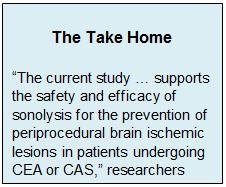Key Points:
- Randomized trial explores benefits of sonolysis during CEA/CAS
- Fewer post-procedure new ischemic brain lesions with sonolysis
Sonolysis reduces the incidence and size of new ischemic brain lesions after carotid revascularization, according to a randomized trial published online September 28, 2015, in the European Heart Journal.
Researchers led by David Školoudík, MD, of Palacký University Olomouc (Olomouc, Czech Republic) randomized patients with carotid stenosis ≥70% who were indicated for carotid endarterectomy (CEA) or stenting (CAS) to sonolysis (n = 121) or control (n = 121). Both groups were similar with regard to age, sex, severity of disease, and vascular comorbidities. All patients underwent neurological examination, cognitive function testing, and brain MRI prior to treatment and again at 24 to 30 days post-surgery.
Sonolysis was performed as continuous Doppler monitoring of the ipsilateral middle cerebral artery from the start of the intervention using a diagnostic transcranial Doppler machine (DWL MultiDop T1, DWL Elektronische Systeme Sipplingen, Germany) and a 2 MHz diagnostic transcranial Doppler probe. The probe was fixed in the required position using a helmet, with an insonation depth of 55 mm, sample volume of 10 mm, power of 200 mW, and thermal index in the cranium of 3.1.
Controls underwent a similar setup but without transcranial Doppler monitoring. Device sound and Doppler wave imaging were disabled to maintain blinding of the intervention team.
After revascularization, new ischemic brain lesions—including those measuring at least 0.5 mL—occurred less frequently in both hemispheres among patients who received sonolysis (table 1).

Independent predictors of lower risk were sonolysis (OR 0.45; 95% CI 0.22-0.94) and CEA (OR 0.21; 95% CI 0.09-0.50).
Stroke or TIA occurred in 1 patient in the sonolysis group and 3 in the control group. There were no deaths or MIs, and no differences between the 2 groups with respect to post-intervention cognitive test scores. The authors note that the study sample was not large enough to determine conclusively if sonolysis affects these outcomes.
‘Promising’ but Mechanism Unclear
“A recent meta-analysis concluded that sonolysis is a promising method for improving outcome in acute ischemic stroke patients,” write the authors. “The current study also supports the safety and efficacy of sonolysis for the prevention of periprocedural brain ischemic lesions in patients undergoing CEA or CAS,” with sonolysis being associated with a reduction in both lesion incidence and mean volume in both procedures.
It remains unclear how sonolysis reduces lesion incidence and volume, they say. [I]t is assumed that ultrasonic waves accelerate enzymatic fibrinolysis by increasing the transport of fibrinolytic agents (eg, plasmin) into the thrombus by mechanical disruption of thrombus structure, direct activation of fibrinolytic enzymes, and transient peripheral vasodilatation. Activation of fibrinolytic enzymes and disruption of thrombo-emboli may account for reduced lesion incidence and volume in regions outside that directly exposed to ultrasound energy.”
Larger trials, the researchers acknowledge, are need to confirm the clinical benefits of sonolysis.
Source:
Školoudík D, Kuliha M, Hrbáč T, et al. Sonolysis in Prevention of Brain Infarction During Carotid Endarterectomy and Stenting (SONOBUSTER): a randomized, controlled trial. Eur Heart J. 2015;Epub ahead of print.
Disclosures:
- Školoudík reports no relevant conflicts of interest


